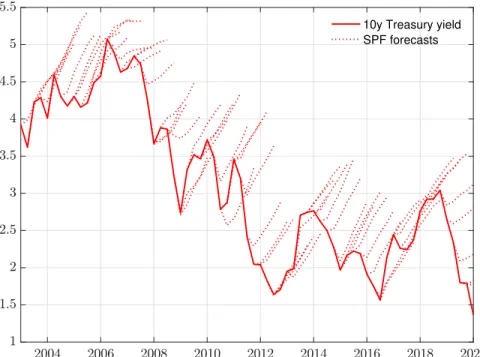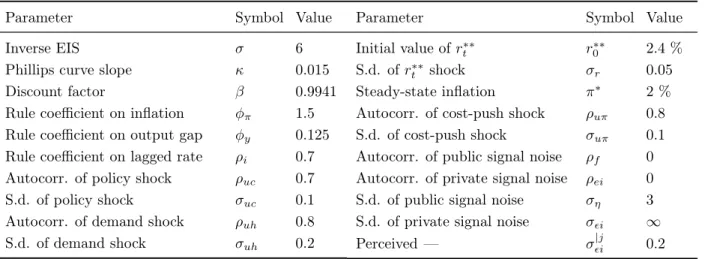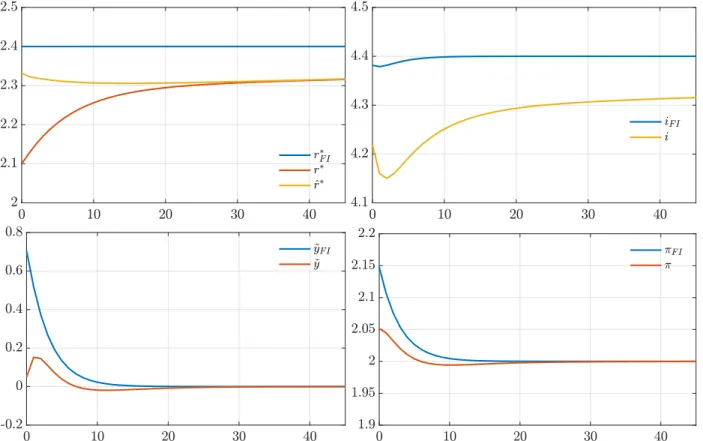Few concepts have had a greater impact on monetary policy in the past decade than the natural rate of interest, or r-star—the real rate of interest consistent with equal potential output and stable inflation. But there is also evidence that the expected short-term rate in the long run is sensitive to monetary policy.
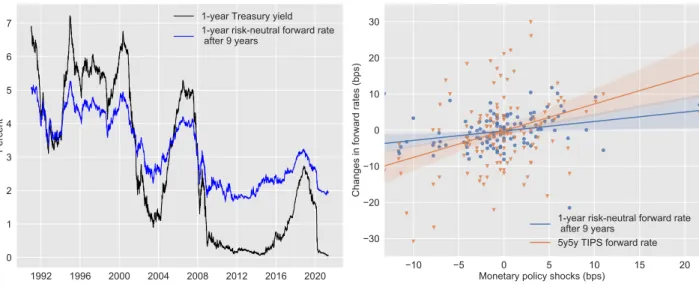
The belief-driven natural interest rate
3.6) The monetary policy shock is perceived by the central bank, but not by the private sector. The two coincide only when the central bank and the private sector share the same beliefs, so that Etc=Eth.
The 2-period model
Furthermore, the interest rate that prevails in equilibrium becomes a weighted average between the beliefs of the private sector r∗ and that of the central bank rˆ∗. To form beliefs about the natural rate of interest, the private sector and the central bank rely on different sources of information.
Inference problem
Observing these results allows each party to obtain information about the other party's private signal. These endogenous signals are publicly visible through observations of the nominal interest rate and the output gap.
Common knowledge equilibrium
The red line follows the central bank's estimate rˆ∗ as a function of = r∗, and has a positive slope gac. Note: Each panel shows the central bank's estimate of r-star rˆ∗ ≡ Ec[r∗∗] as a function of the noisy observation of the private sector's expectationah≡r∗+uh(red lines), and the private sector's factor-star r∗≡Ec[r∗∗] of the∗≡Ec[rˆy is a function of the ∗≡Ec[rˆy function of the ≡rˆe expectation of the∗] ∗+uc(blue lines) ). 7 This special case also applies if the central bank has imperfect information, but can perfectly observe the private sector's expectation.
The private sector cannot readily distinguish between monetary policy shocks and changes in the central bank's information on r-star and thus attaches some weight to the possibility that the natural real interest rate has fallen. This general case is depicted in the left panel of Figure 4, where the de facto r∗ of the private sector and the central bank estimatesˆ∗ are both increasing functions of each other.
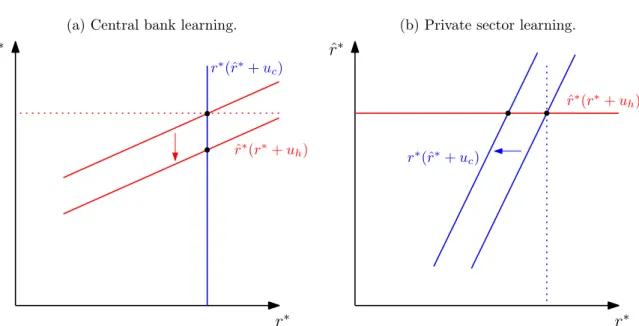
Hall-of-mirrors equilibrium
The private sector responds by sharply lowering its own estimate of r-star because it overestimates the precision of the central bank's information about the economy. Because the private sector misperceives the central bank's response function, it only expects the policy rate to rise by gaj|iui, resulting in a surprise of. The slope of the central bank response function (red line) is g|cac and the slope of the private sector response function (blue line) is 1/g|hah.
The private sector response function is shifting to the right, but in a different way than commonly known. The reason is that the private sector mistakenly believes that the central bank has very good private information and will not respond much to the expectations of the private sector.
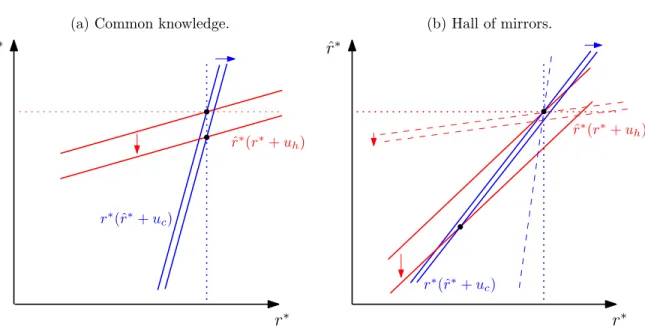
Macroeconomic implications
But the indirect learning effect leads to a drop in the term r∗−rˆ∗ as the private sector adjusts their belief in r-star by more than the central bank. This has a negative effect on output, as the central bank cuts interest rates by less than necessary to absorb the shock. While incomplete information and the hall-of-mirror effect tend to dampen movements in output and inflation, they also amplify movements in r-star expectations and interest rates.
An outside observer might conclude that the structural relationship between interest rates and real activity is weak. We will show that the hall-of-mirrors effect not only amplifies noise to r-star beliefs, but also generates misperception that can be very persistent under plausible parameters.
Fundamentals and exogenous signals
As usual, a negative interest rate shock uc < 0 has a direct widening effect on the output gap. The information structure and associated qualitative equilibrium results all carry over from the static model presented above. In addition to these signals, the model has three transitory macroeconomic shocks: demand shocks, cost-push growth shocks, and the uct monetary policy shock.
The private sector is expected to observe demand shocks and cost shocks, but not a policy shock. Meanwhile, the central bank observes the effect of the political shock, but not the shock and the increase in demand and cost pressure.
Macroeconomic outcomes and endogenous signals
The private sector observes the nominal interest rate, in addition to its private signal sht and the public signal xt, and it also observes demand and cost-push shocks uht and op. But it does not respect Etcrt∗∗and uct separately in the policy rule (5.9) and must estimate these objects. The central bank observes the current inflation πt and the output gap y˜t in addition to its private signals and the public signal xt.
It determines the nominal interest rate according to the Taylor rule as a function of inflation, the output gap, its current period estimate of r-ster, as well as the monetary policy shock. We assume that the coefficients φπ and φy in the monetary policy rule yield a unique solution for given expectations of the exogenous fundamentals.
Solution with common knowledge
The equilibrium coefficients can be found using the following system of equations: . 5.19) Finally, we need to calculate the observation matrices Hi. This step is more complex than with the static model, because the endogenous signals provided by observations of macroeconomic outcomes now rely on both fundamentals and first- and higher-order beliefs. Appendix C resolves the macroeconomic outcomes of the model as a function of private sector beliefs, showing that the central bank signal matrixHc is a function of the parameters of the macroeconomic model, as are the matrices Az,Φh,Ψh,Ωh.
The signal matrix for the private sector Hh does not depend on other parameters in the model. Our numerical results show that when N is large enough, the choice of N does not affect the equilibrium dynamics.
Misperception equilibrium
Macroeconomic outcomes in the misperception equilibrium are again determined by private sector beliefs, and we move this formula to Appendix C. We now use a calibrated version of our dynamic model to explore potential quantitative implications of the hall of mirrors effect. As the previous analysis suggests, the answer will depend in part on the degree of misperception.
The resulting uncertainty about r-star in the absence of misperception corresponds to 90% confidence intervals of subjective r-star beliefs of ±2.5%, which is large but within the range of empirical studies.13 In addition, we assume a large degree of misperception: Despite having no useful private information at all, each party believes that the other party has valuable private information (0.2|j). The resulting uncertainty for r-star corresponds to a 90% confidence interval of ±0.9% for the private sector and ±1.4% for the central bank, which is again close to the empirical estimates by Holston et al.
A demand-driven recession
The trajectories of the simulated variables under misperception show the same patterns as. post GFC data pretty good. By constructing shocks in the simulation, the output gap and inflation are reduced by similar amounts as in the data. Most strikingly, the r-star estimate based on Holston et al. 2017), a popular benchmark for inflation- and output-estimated r-star, agrees well with the model's prediction of the central bank's estimate of r-star.
Second, the central bank's perceived r-star is decreasing more than that of the private sector, making the monetary policy stance more accommodative than what Taylor's rule of inertia would dictate. The reason is that private sector agents in the model are unaware of their predictable overreaction.
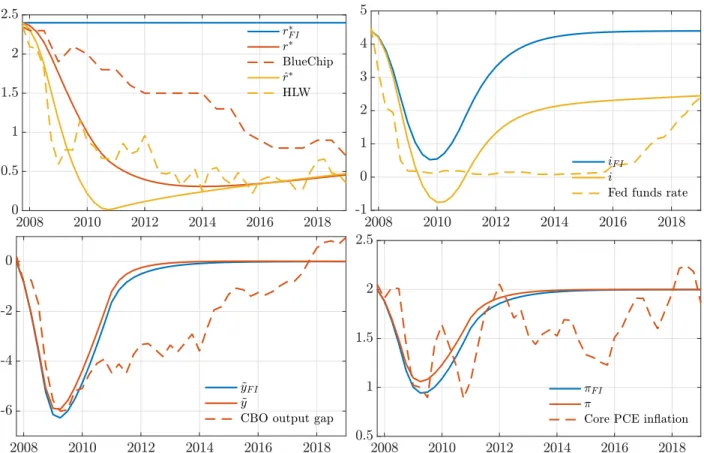
Monetary policy shocks
Only when r-star expectations stop falling does the bias in predicted interest rates all but disappear in our model. The upper right panel of Figure 6 shows that long-term future real rates react to monetary policy surprises, as in the data.15 In the model, this correlation arises from the signaling channel: The private sector interprets downward surprises in nominal interest rates as signaling information on behalf of the central bank that r-star has fallen. Finally, the bottom two panels of the figure show that the broad movements of the yield curve also match the data.
As discussed in section 2, these stylized facts are collectively difficult to explain if one maintains that r-star must be independent of cyclical phenomena. Note: Simulation of yield curves and forward interest rates, constructed using expected interest rate path and assuming the expectation hypothesis holds.
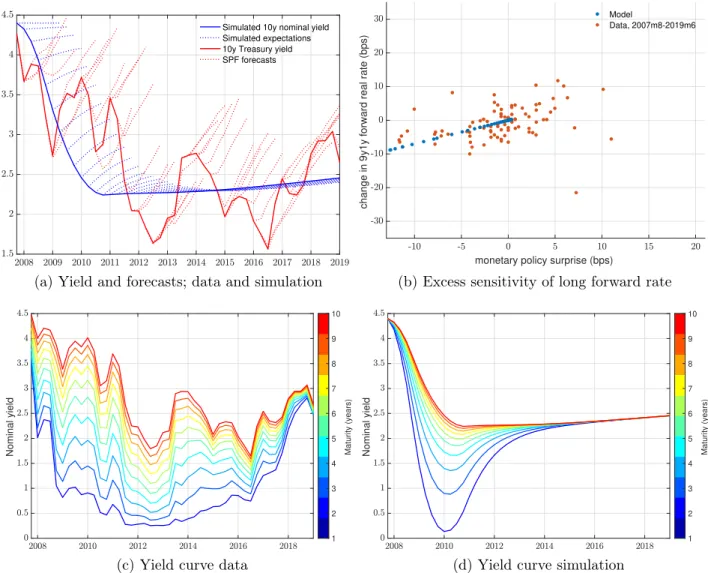
Sensitivity to alternative information structures
Second, it could be fruitful to examine the normative implications of the hall-of-mirrors effect for the design of monetary policy. Lippi (2005): "Endogenous monetary policy with unobserved potential output," Journal of Economic Dynamics and Control Monetary policy, inflation, and the business cycle: an introduction to the new Keynesian framework and its applications, Princeton University Press. Wright (2018): “The Excess Sensitivity of Long Term Rates: A Tale of Two Frequencies,” Staff Report 810, Federal Reserve Bank of New York. 2022): "The Fed and the Secular Decline in Interests," Working paper.
Williams (2007): "Robust monetary policy with imperfect knowledge," Journal of Monetary Economics carnegie-Rochester Conference Series on Public Policy: Issues in Current Monetary Policy Analysis November Learning, expectations formation, and the pitfalls of optimal control monetary policy," Journal of Monetary Economics, 55, S80-S96. Disyatat (2019): "Monetary policy hysteresis and the financial cycle," BIS Working Papers Uncertainty and the Signaling Channel of Monetary Policy," Working Paper 15-8, Federal Reserve Bank of Boston.

Model building blocks
Note that we again use the Eth expectation operator under the assumption that firms and households share the same information set, economic model, and perception of the accuracy of their signals relative to the central bank signals. The marginal cost of an individual firm ψt+k|t is the wage at t+k minus the marginal product of labor at t+k to reset the firm at t. These must be resolved in a general balance and will depend on future employment, i.e. output and price.
0 ψt(i)di is the cross-sectional average marginal cost. where µˆ≡µt−µ is the deviation between the average markup µt ≡pt−ψt and the desired markup. Thus, there is a difference between the de factor∗t as defined here and its perfect information counterpart, r∗∗t.
Proof of Proposition 1
Since this holds for i = c, h, there exists at least one pair (gsh, gsc) that satisfies the equilibrium conditions. It follows that there are at most three pairs (gsh, gsc) that satisfy the equilibrium conditions.
Proof of Proposition 2
Proof of Proposition 3
The coefficient matrices Γ,Θ and θs depend on the parameters as well as on the matrix Az. Equations (5.13) and (5.14) form a standard linear filtering problem whose solution is given by the Kalman filter. The household observes sht, xt, uht, upt, as well as the nominal interest rate det.
It can be seen from the monetary policy rule (5.9) that its consideration and y˜t and πt (which are variables of the household's own choice) is equivalent to observing Etczt+uct in each period. Its information about the household's expectation comes from observing y˜t and πt, which are themselves equilibrium outcomes that depend on the household's beliefs in a non-trivial way.
Model counterpart to high-frequency policy surprises
